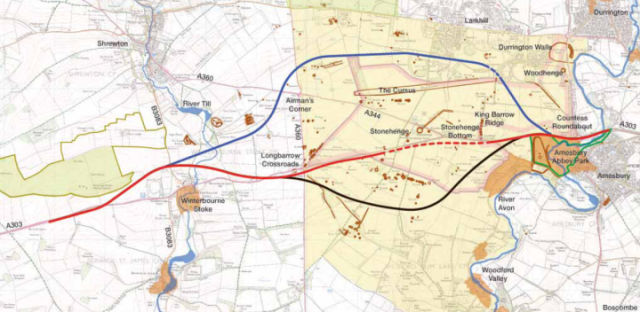The anticipated National Trust member rebellion over the charity’s backing for the Stonehenge tunnel failed to materialise at yesterday’s AGM held at the STEAM museum in Swindon, Wiltshire.
For over 30 years there have been failed attempts to remove the road dissecting this unique archaeologial landscape. The Government proposes to make the section of A303 through the World Heritage Site (WHS) a dual carriageway, but through persistent pressure have altered the scheme to construct a fully bored tunnel at a cost of £1.4 billion. The National Trust has been an owner, guardian and champion of the Stonehenge landscape for almost 90 years but its support for the tunnel has caused concern among many members.
Consequently two member’s resolution had been put forward for debate at the AGM; the first resolution concerned the A303 at Stonehenge.
First Resolution: The A303 Tunnel
At the beginning of this year the Government’s agency, Highways England, unveiled its plan to upgrade the A303 to an ‘expressway’ with a short, 2.9km (1.8-mile) tunnel through the 5.4km (3.4-mile) wide Stonehenge WHS. If the plan were to go ahead an entirely new dual carriageway, deep cuttings, and tunnel entrances would be introduced on a brutal scale into this country’s premier archaeological landscape.
However, it is argued that an expanded road would simply draw significantly more traffic into the WHS and the new alignment would blight a currently tranquil areas with noise and light pollution. Flyover junctions would intrude on the setting of the WHS at both its eastern and western boundaries. The road scheme threatens permanent loss and damage to archaeology including at Blick Mead, a newly discovered and uniquely significant Mesolithic site.
Members warned the National Trust (NT) that it is “compromising its reputation” with its support for a controversial tunnel cutting through the sacred Stonehenge site on a “brutal scale”, after the charity gave its support to a plan that will “inject enormous amounts of concrete into the most significant prehistoric landscape if not in Britain, in the whole of Europe”.
NT members demanded that it rethink its position on the proposal to upgrade the choked A303 following more than two decades of heated debate over plans to reassign the notoriously busy route linking London to the South West of England.
Widespread objections to the scheme from leading conservation bodies, numerous archaeologists with unparalleled expertise in the Stonehenge landscape and thousands of petitioners from all over the world has resulted in accussations that the Trust is prioritising Government criteria above opposition from environmental and archeological lobbies and astronomical costs.
The road tunnel has been condemned by UNESCO, the agency that oversees world heritage sites, and has urged the government to build a bypass instead and questionned the position of the NT.
The Board of Trustees’ response argued that the existing A303 severs and blights the WHS, impacting over 50 monuments, including Stonehenge, and severely damages the international significance of the site, undermining the ability to share this special place in its entirety. Along with partners at Historic England, English Heritage Trust and Wiltshire Council, the Board are very clear that the current situation cannot continue and recommended that the membership vote against the resolution.
The vote was narrowly lost yesterday and despite its reservations, such as the location of the western tunnel portals and wildlife, the NT will continue to support the road scheme.
Second Resolution: Trail Hunting
The second member resolution required that the NT will not permit trail hunting, exempt hunting and hound exercise on their land, to prevent potential illegal activity in breach of The Hunting Act 2004 and The Protection of Badgers Act 1992 and to prevent damage to other flora and fauna by hunts, their hounds, and their followers.
 Since hunting with dogs became illegal in 2005, the NT has issued licences for ‘trail hunting’ in which, allegedly, an artificial trail is laid for the hunt to follow. The supporters of the resolution however believe that sufficient evidence exists to show that illegal hunting is taking place regularly on NT land.
Since hunting with dogs became illegal in 2005, the NT has issued licences for ‘trail hunting’ in which, allegedly, an artificial trail is laid for the hunt to follow. The supporters of the resolution however believe that sufficient evidence exists to show that illegal hunting is taking place regularly on NT land.
The NT insists it monitors the activities it licenses and has taken action against trail hunts on six occasions over the past five years. However, last year, 79 licences were issued to 67 hunts for use of NT land. NT claimed that hunts have had licences removed or suspended following reports by National Trust staff and members.
Members also voted narrowly at yesterday’s AGM against the ban on trail hunting, failing to ban legal hunting on NT land by less than 300 votes.
Under NT rules, members cannot now introduce another motion to ban hunting for a further four years.
Mis-placed Trust?
Sadly, the result of these two votes raises a high degree of disillusionment with the National Trust; as a guardian of heritage and conservation it has missed the opportunity to put animal welfare and the archaeological environment first. After all, alterations to the A303 through a World Heritage Site are all about costs; the real solution is a diversion well away from this unique landscape.
Secondly, with the failure to ban trail hunting, an activity that masks the illegal continuation of hunting with hounds, the NT has missed a opportunity to remove this barbaric dark age “sport” from its lands.


You must be logged in to post a comment.